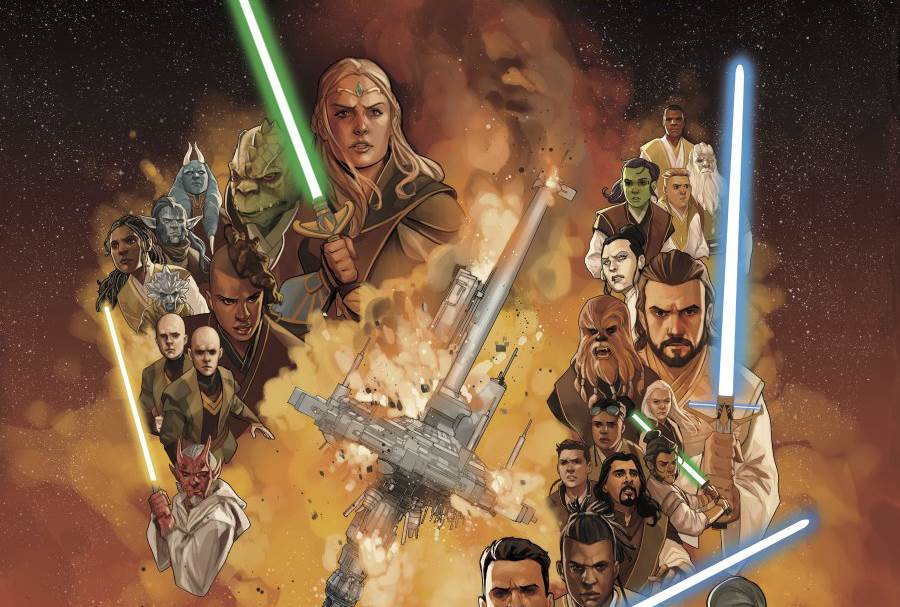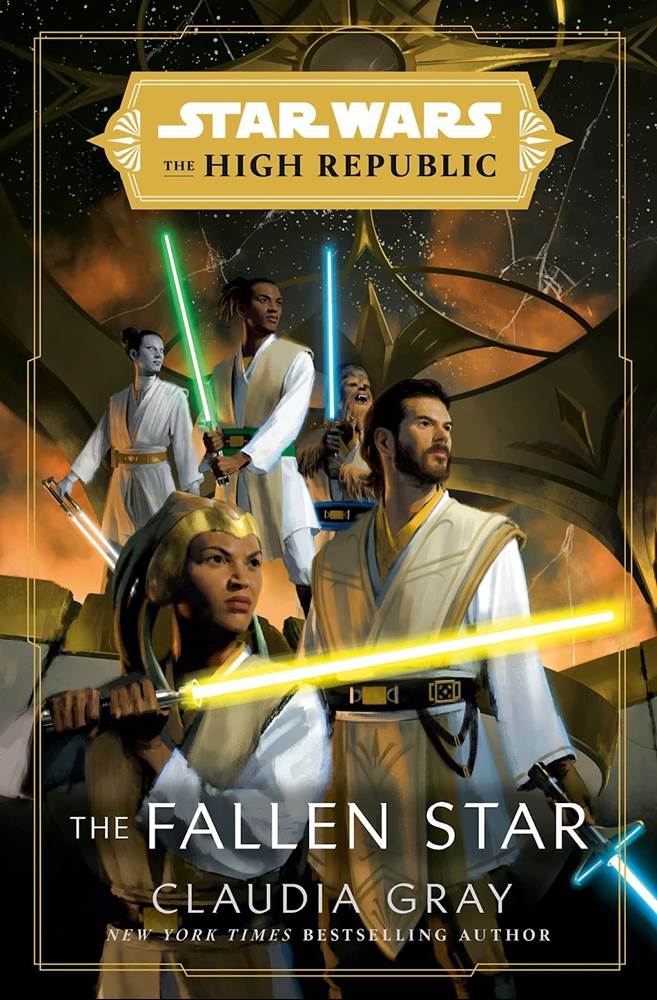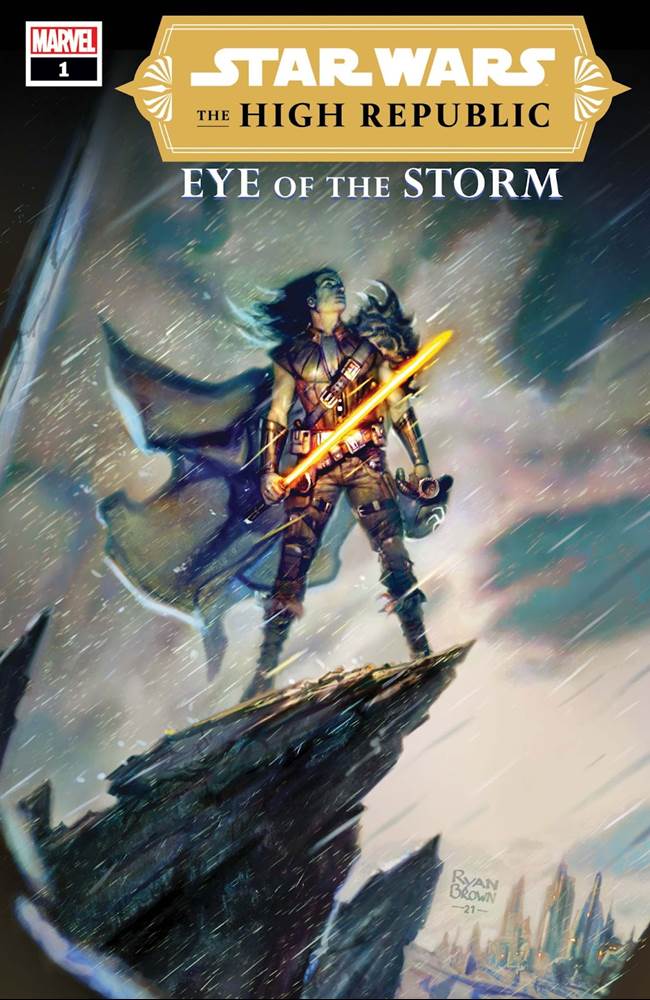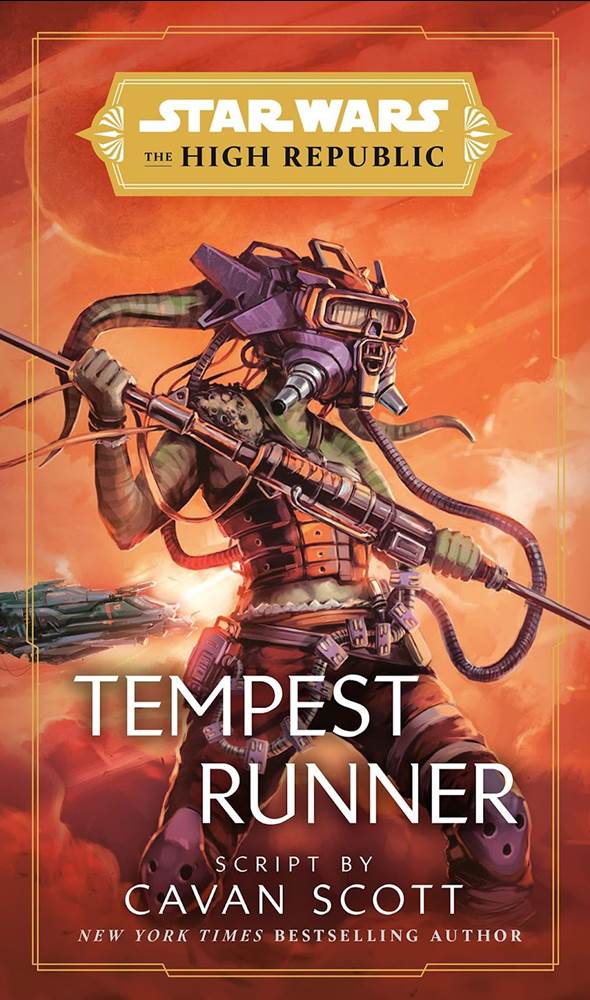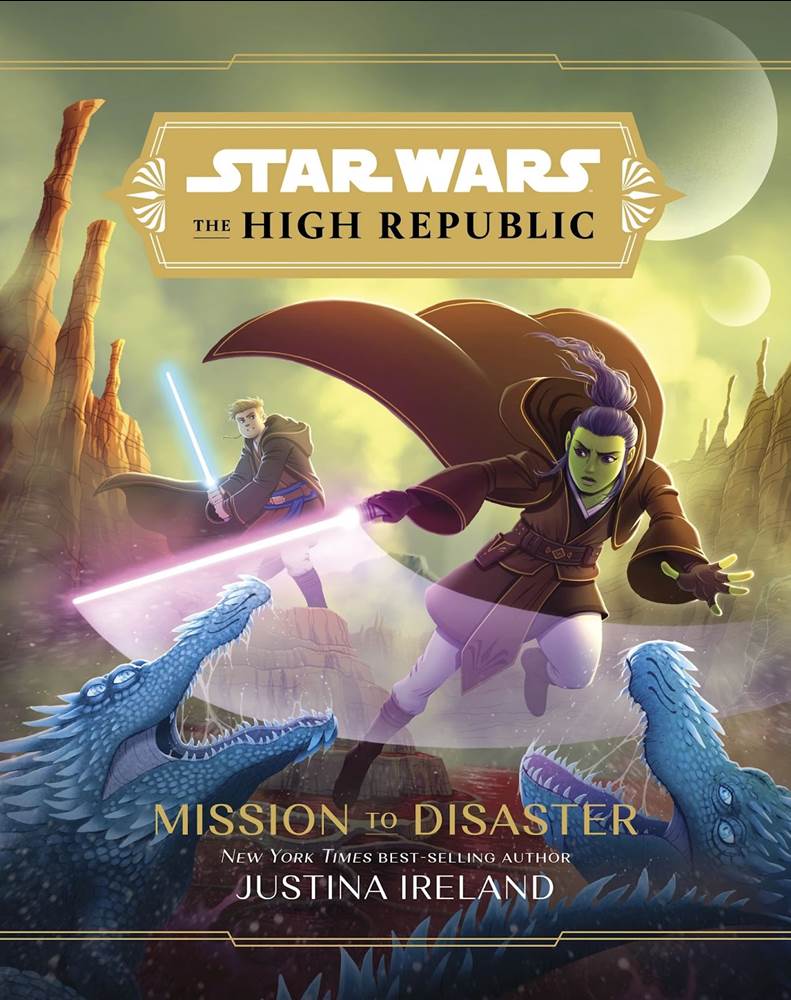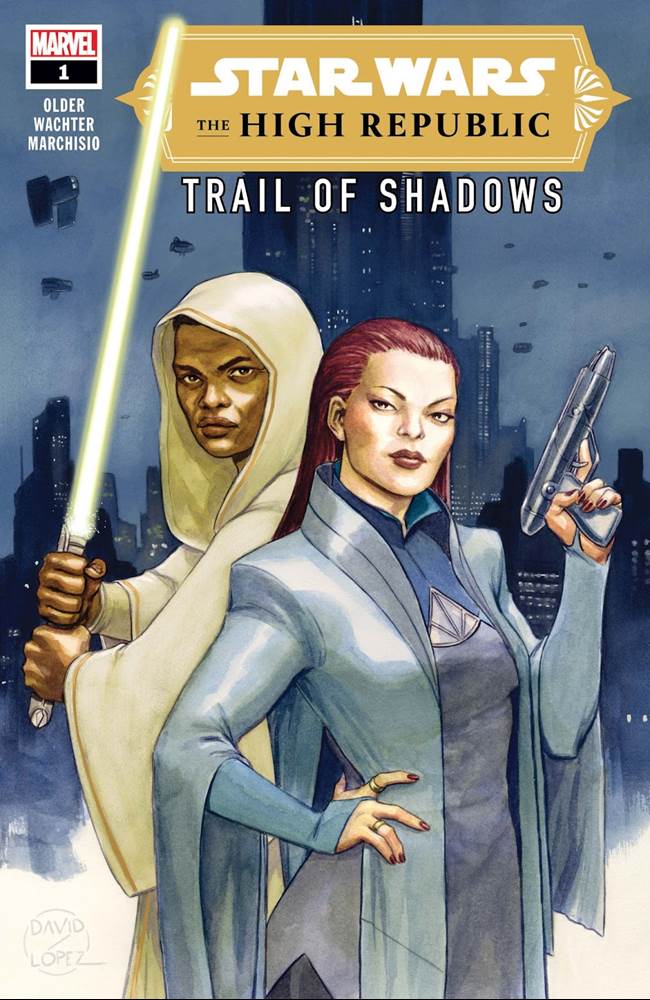Interview – “Star Wars: The High Republic” Authors Debrief Phase I of Lucasfilm’s Publishing Initiative
At the beginning of 2021, Lucasfilm Publishing launched an ambitious new initiative known as Star Wars: The High Republic, set during the prime of the Jedi Order– some 200 years before the events of the Skywalker Saga. And earlier this year, Phase I of The High Republic wrapped up with a number of new novels and comic books by acclaimed authors Claudia Gray, Justina Ireland, Daniel José Older, Cavan Scott, and Charles Soule.
At the recent Star Wars Celebration convention in Anaheim, California, I had the wonderful opportunity to sit down with the above-listed authors to debrief the first phase of Star Wars: The High Republic and look ahead to this fall’s Phase II.
Mike Celestino, Laughing Place: First of all, congratulations. You must be thrilled at the response Star Wars: The High Republic is getting.
Claudia Gray: Very much so.
Charles Soule: It’s amazing.
LP: During the Star Wars Celebration panel for The High Republic, Lucasfilm Publishing’s Michael Siglain said, “pain has been a part of this plan from the beginning." And Claudia, since you wrote The Fallen Star, which was the climactic novel in Phase I, can you talk about why the themes of loss and death are so important to Star Wars?
Gray: Oh gosh, I mean… Palpatine would be right there saying, ‘Not really.’ [laughs] I think the thing that was really important… I really come back to Stellan [Gios] in this. This is a character that, in a lot of ways, I connected to so much more deeply after it was decided he was going to die. Because the real pain of this is we’ve had so many Jedi die because ‘The Leveling’ cut [them] off from the thing that is the most valuable to them: their connection to the Force. That’s the most horrible thing that can happen to a Jedi– not just to die, but to lose themselves in that way. And I liked being able to use Stellan’s death as a counterweight to that. He dies, but he dies in a way that is allowing him to find himself again. He was in danger of caring too much about what everybody saw of him, and where he was in relation to all this, instead of his own deep, internal connection. Having him get that back… that’s what happens for him. I mean, the death is sad, but I really felt like that was a huge redemptive element to it. I wanted to see somebody have the kind of death that we would want these great characters to have.
Cavan Scott: Dying, and how we cope with it, is part of living. And I think as a society we’re very good at brushing it under the carpet: ‘Well that’s a thing that happens, but let’s not think about it.’ But it affects every part of our relationships, it affects every part of our families, our friends… it will happen at some point in your life. You will have to face it. And like all good fiction, [Star Wars] is preparing you for these moments– asking those questions of yourself. For me, the exciting thing about The High Republic is yes, we have these moments when people die, but characters survive and they get changed by those deaths, and their relationships to those people.
Gray: And then they die. [laughs]
Daniel José Older: I always come back to the conversation in [Star Wars: The High Republic Adventures] between Obratuk and Farzala, where Obratuk is really trying to push him on that idea: ‘If you’re really about the Force and what it means to live as one with the Force and in balance with the Force, and that when you die you become part of the Force, then… it’s sad for the people that miss you, but it’s a beautiful thing to become part of this great thing that you’re living in balance with. And yes, they’re all humans, and that’s what makes them so interesting as characters to write. Otherwise, if they were just cool with everything, it would suck. [laughs] But they’re also kind of tasked with finding peace within that, even though there is tragedy around them. And I think we are too, in a way.
Soule: [In] Star Wars, it’s not always like Stellan dying, right? You also have the Gamorrean guard getting eaten by the Rancor. Sometimes it’s sort of goofy– plenty of stormtroopers falling with Wilhelm screams. And then there’s the Death Star destroying Alderaan or Hosnian Prime [being destroyed by] Starkiller. It happens in all these different ways, on all these different scales. It means different things for different characters, and how much investment you have in them, but to go back to what Cavan just said, if you’re writing good stories, death should be a part of it. And death affects us all in different ways– the way that we react to it, the way you process it, the way you think about it, the way you internalize it… it is literally part of being alive, and so Star Wars is good storytelling because it addresses it.
Gray: Yeah, and I think one thing that’s really important is because Star Wars, with stuff like Alderaan or a lot of what was happening in The Rise of Skywalker– it’s big, and it’s very hard to feel that. But with [The High Republic], yes, we have that big, spectacular death of Starlight [Beacon], but by that time we’d been able to get people to emotionally engage with that, to know so many of the characters that are there and are living or dying through that. I feel like that always has so much impact.
LP: Charles, you wrote Eye of the Storm, the comic miniseries about Marchion Ro. In your opinion, what sets the Nihil– and Marchion as their leader– apart from other villains? What makes them unique and interesting besides the technology and weapons at their disposal?
Soule: The villains that we’ve seen in Star Wars, generally speaking, kind of work within a code. They’ve got a set of rules. Order is their goal– both the Empire and the First Order, what they’re trying to do is establish control. And the Nihil, from the start, are like, ‘We don’t want to control anything. We just want to do what we want to do. We want you not to control us.’ So that is flipping the traditional Star Wars villain on its head in a way that I think is compelling. And like a lot of storytelling, it’s a reaction to [its] time. A lot of people are just like, ‘We just want to live the way we want to live, and we don’t want you to tell us to do what we have to do. We’re just gonna do it.’
Soule [continued]: [The Nihil] approach that impulse in a very negative and destructive way: ‘If you tell me what to do, I will kill you so you are not able to tell me what to do anymore. So they’re scary. The idea that somebody out there is willing to just kill you because they don’t like the cut of your jib, basically– I think that’s why they’re scary, and I think Marchion Ro in particular is scary because he is the one who made them that way. He’s the one who instilled that ‘codelessness’ code in them. And other people don’t really exist to him. Other people are only tools that he can use to feel good, and to feel alive, and to feel special. I bet we’ve all met people like that personally. They’re very very frightening, and I just cranked it up to 11 with him.
LP: And Cavan, since you wrote the audio drama Tempest Runner, how does Lourna Dee factor into that equation? What twist on that formula does that character provide?
Scott: Lourna is a proper quintessential tragic character in all this, because she has the chance [to stop]. You’re yelling at Lourna, ‘Just stop! Just think about what you’re doing,’ and she goes back to the same old self-destructive thing. Through Lourna, we can explore the fact that [the Nihil] are a bunch of people who are always evolving, but keep getting trapped in the same old cycles. I think that’s one thing that people are going to notice as we move into the future phases. They do evolve. The Nihil we meet in Light of the Jedi aren’t the Nihil that we’re going to see in three or four years' time.
We have had a lot of infighting between the Tempest Runners because of the nature of the organization that Marchion has put together. That was always going to happen. I’ve loved when we’ve been [developing] those characters, especially the relationship between Lourna and Marchion. He is absolutely getting hoisted by [his] own petard. He’s always saying to [the Nihil], ‘You can do anything you want,’ and Lourna is like, ‘Okay, I want [Marchion’s] job.’ She’s great because she just pushes all the boundaries all the time, but at the same time you’re just saying, ‘You could be more than this.’ And she doesn’t quite see that.
LP: Justina, in Mission to Disaster, we got to meet some new Jedi and a new villain. How are these characters built in to pay off later on in the overarching story?
Justina Ireland: We always knew where we were going with the storytelling, so even things that feel like throwaway mentions are breadcrumbs. They’re leading you to the path of this entire story that we’ve built. I always appreciate how things read on the second read-through, which is probably not something that anybody ever wants to hear. [laughs] But as a writer you read through your [own] stuff a lot, so I’ve learned to appreciate even other people’s books on the [second] read-through. A lot of this stuff, once [The High Republic] is done, once all the books are out, people will be able to go back to the beginning and see pieces that they’ve missed. And I think for me, as a fan, that’s always something I enjoy.
LP: Daniel, I have to compliment you on Trail of Shadows. It’s one of my favorite things I’ve read so far and I love how you integrated mystery, noir, and horror into Star Wars. What was it like being able to play with genre in that way?
Older: That’s amazing to hear. I appreciate it. It was a dream come true, and what’s cool is those elements have also been there in Star Wars, but in the shadows a little bit. You know, we’ve had Clone Wars episodes that are really steeped in noir, which I love. I think Star Wars just fundamentally is so much about respecting and calling back to some of the film greats from the past. That’s always been the vision of Star Wars, but while also looking forward into the future and doing it with edginess and with verve, and within this world. So it felt very natural to do it. I was excited by the challenge– it was definitely a challenge, but I drew from my long love of noir, and also having music in there and different elements like that to throw in and really mix it up. I wanted it to feel really vibrant even as it was feeling really dark and mysterious and shadowy, so finding that balance was kind of the mission of the whole thing.
LP: What excites you the most about the future of The High Republic?
Older: I’m really excited about Phase II. I’m also really excited about Phase III, but since Phase II is what we’re staring down and working on right now, I have so much [excitement for it], especially after that panel and just hearing the fan excitement about it. But also [the concept of] going back and telling all these stories from the past and getting the chance to do that. For me, writing Sav Malagán, who was one of my favorite characters to write in Phase I– it’s just really exciting.
Scott: And the new [authors]. We’ve got new voices coming in. I mean, we all hate each other now. [laughs] No, but it’s great. It’s a shot in the arm for us, because we worked together a lot [over] the last couple of years, and now we have new voices and new ideas. That’s a really exciting part, and for [readers] to experience that. Waiting for people to see that is really exciting.
Star Wars: The High Republic Phase II begins this fall from Lucasfilm Publishing. The audio version of this interview was included in the Star Wars Celebration Anaheim round-up episode of Laughing Place’s Star Wars podcast “Who’s the Bossk?"



